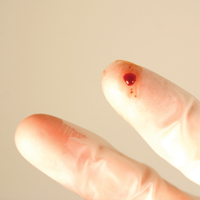Occupational accidents of those exposed to biological risks at health institutions
Keywords:
OCCUPATIONAL HEALTH, OCCUPATIONAL ACCIDENTS, EXPOSURE TO BIOLOGICAL AGENTS.Abstract
Introduction: occupational accident is a sudden fact casually related to work activity, causing damage, illness or death to worker. In the health sector, there are also a number of work-related accidents every year due to the spread of a pathogen or accidental injuries.
Objective: to describe the behavior of occupational accidents in workers exposed to biological risks in health institutions in Pinar del Rio province.
Method: a descriptive and retrospective study was carried out during 2014 to 2015; the target group included 87 health workers injured due to biological risk in the province during this period. Eighty-seven (87) epidemiological surveys were reviewed comprising work-related accidents and the information recorded matched with the variables chosen.
Results: 87 accidents were reported due to biological risk, predominantly women (78.2%), aged 25-34 years. Laboratory workers (27.6%) and nursing staff (26.4%) had more working experience with 5 to 9 years. 95.4% of those injured by biological risk presented lesions in hands with intact skin. 48.3% of the workers were wounded and disinfected, while 21.8% facilitated bleeding and other 21.8% only washed the wound.
Conclusions: the greatest risk of accidents in health workers is in contact with blood and its products. Deep puncture injuries are a major cause of exposure to serious and sometimes fatal diseases. The poor quality of the means of protection could affect the occurrence of occupational accidents. An adjustment of the Biological Safety Program is required, considering at the same time the factors of human behavior to avoid biological risk accidents.
Downloads
References
1. Gambino D, Padrón J. Bioseguridad: tarea prioritaria en instituciones de salud. Rev Cubana de Salud y Trabajo 2014;15(3):58-62. http://bvs.sld.cu/revistas/rst/vol15_3_14/rst09314.htm
2. Barbosa Maria Helena, Floriano Daniela Rosa, Oliveira Karoline Faria de, Nascimento Kleiton Gonçalves do, Ferreira Lúcia Aparecida. PATIENT SAFETY CLIMATE AT A PRIVATE HOSPITAL. Texto contexto - enferm. [Internet]. 2016 [cited 2017 Feb 01]; 25(3): e1460015. Available from: http://www.scielo.br/scielo.php?script=sci_arttext&pid=S0104-07072016000300312&lng=en.%20%20Epub%20Sep%2012,%202016.%20%20http://dx.doi.org/10.1590/0104-07072016001460015.
3. Manual de Bioseguridad en el Laboratorio 3a Edición. OMS 2005 [Internet]. Es.slideshare.net. 2016 [cited 16 May 2016]. Available from: https://es.slideshare.net/marcovinicioroblesaguilar/manual-de-bioseguridad-en-el-laboratorio-3a-edicin-oms-2005
4. Hernández R, Castellanos MI, Folgueira RM, Cendan A, Turcaz N. Prevalencia de hepatitis virales b y c en trabajadores del Instituto de Gastroenterología de La Habana. Rev Cubana de Salud y Trabajo 2014;15(3):24-30 http://bvs.sld.cu/revistas/rst/vol15_3_14/rst04314.pdf
5. Valdés MV, Perdomo M, Salomón J. Caracterización y categorización de los riesgos biológicos en el laboratorio clínico del policlínico docente ‘Rampa’, municipio Plaza de la Revolución, La Habana, Cuba. Rev Cubana de Salud y Trabajo 2014;15(2):40-6 http://bvs.sld.cu/revistas/rst/vol15_2_14/rst07214.pdf
6. Gómez DA, Muñoz DP. Caracterización de los accidentes laborales en un hospital de alta complejidad de la región de Antioquia, Colombia. Rev Cubana de Salud y Trabajo 2015;16(2):31-6. http://bvs.sld.cu/revistas/rst/vol16_2_15/rst05215.pdf
7. Occupational Health & Safety and Infection Prevention & Control - Flu - Health Care Providers - MOHLTC [Internet]. Health.gov.on.ca. 2016 [cited 4 March 2016]. Available from: http://www.health.gov.on.ca/en/pro/programs/publichealth/flu/ohs.aspx
8. Arnold Y. Bioseguridad y salud ocupacional en laboratorios biomédicos. Rev Cubana de Salud y Trabajo 2012;13(3):53-8. http://bvs.sld.cu/revistas/rst/vol13_3_12/rst08312.htm
9. Ramírez Álvarez F. ARL SURA - Riesgos Laborales - ARL - Prevención y manejo de los accidentes biológicos [Internet]. Arlsura.com. 2016 [cited 6 June 2016]. Available from: https://www.arlsura.com/index.php/centro-de-legislacion-sp-26862/161-sectorsalud/sector-salud-/946-prevencion-y-manejo-de-los-accidentes-biologicos
10. Occupational Health Surveillance and Evaluation Program (OHSEP) [Internet]. Cdph.ca.gov. 2016 [cited 22 May 2016]. Available from: https://www.cdph.ca.gov/programs/ohsep/Pages/default.aspx
11. Huaman L. Bioseguridad en hemodialisis [Internet]. Es.slideshare.net. 2016 [cited 25 February 2016]. Available from: https://es.slideshare.net/luchine/bioseguridad-en-hemodialisis-36889764
12. Infection Prevention and Control in Personal Services Settings Protocol, 2016 [Internet]. 1st ed. Ontario, Canadá: Queen’s Printer of Ontario; 2016 [cited 9 June 2016]. Available from: http://www.health.gov.on.ca/en/pro/programs/publichealth/oph_standards/docs/infection_prevention_personal_services.pdf
13. Reduction of Healthcare-Associated Infections by Exceeding High Compliance with Hand Hygiene Practices. Emerging Infectious Diseases [Internet]. 2016 [cited 11 January 2016];(9):1628-30. Available from: https://wwwnc.cdc.gov/eid/article/22/9/pdfs/15-1440.pdf
14. Guía sobre la reglamentación relativa al Transporte de sustancias infecciosas 2015–2016 [Internet]. Organización Mundial de la Salud. 2016 [cited 16 January 2016]. Available from: http://www.who.int/ihr/publications/who_hse_ihr_2015.2/es/
15. Proceedings of the Consensus Conference on Infected Health Care Workers: risk for transmission of bloodborne pathogens. Reports and Publications - Public Health Agency of Canada [Internet]. Phac-aspc.gc.ca. 2016 [cited 24 April 2016]. Available from: http://www.collectionscanada.gc.ca/webarchives/20071124025757/http://www.phac-aspc.gc.ca/publicat/ccdr-rmtc/98vol24/24s4/index.html

Published
How to Cite
Issue
Section
License
Authors who have publications with this journal agree to the following terms: Authors will retain their copyrights and grant the journal the right of first publication of their work, which will be publication of their work, which will be simultaneously subject to the Creative Commons Attribution License (CC-BY-NC 4.0) that allows third parties to share the work as long as its author and first publication in this journal are indicated.
Authors may adopt other non-exclusive license agreements for distribution of the published version of the work (e.g.: deposit it in an institutional telematic archive or publish it in a volume). Likewise, and according to the recommendations of the Medical Sciences Editorial (ECIMED), authors must declare in each article their contribution according to the CRediT taxonomy (contributor roles). This taxonomy includes 14 roles, which can be used to represent the tasks typically performed by contributors in scientific academic production. It should be consulted in monograph) whenever initial publication in this journal is indicated. Authors are allowed and encouraged to disseminate their work through the Internet (e.g., in institutional telematic archives or on their web page) before and during the submission process, which may produce interesting exchanges and increase citations of the published work. (See The effect of open access). https://casrai.org/credit/


